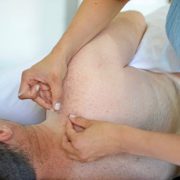Want to lose weight in the New Year? Don’t let knee or back pain get in your way.
If you google “Top 3 New Year’s Resolutions” – you’re sure to find “losing weight” as one of them. While I’m not a dietician or nutritionist, I know that the majority of weight loss has to do with what you eat. However, exercise plays a role too, and that I am an expert in.
Exercise stimulates endorphins and makes you feel better all around. The better you feel, the easier it will be to stay motivated about your weight loss goal.
Exercise also helps you burn more calories – which certainly isn’t going to hurt your weight loss journey.
But if you’ve got unchecked knee or back pain, not only will you find it challenging to exercise, you are going to be more stressed about it. Stress increases cortisol which interferes with your ability to manage weight. And if you can’t exercise at all because of pain, that will make it even harder to manage stress, never mind your weight. You can see how this vicious cycle from unwanted knee and back pain could completely derail your New Year’s goals.
Here are four tips to help you not let knee or back pain get in the way of your weight loss in the New Year:
1. Mobility Before Stability
Your muscles can’t function at their best if you don’t have optimal joint mobility. In other words, you don’t want to strengthen around a joint that isn’t moving at its best, or you’ll encourage compensation. If your nagging back or knee pain is due to inadequate mobility, you’ll run into problems. You will be in more pain if you suddenly increase your exercise or activity level. We saw this happen at the beginning of the pandemic. People started walking and exercising more and we saw a huge influx of unexpected back and knee pain as a result. Their joints weren’t accustomed to moving so much and it highlighted the lack of mobility and compensations. Don’t let the same thing happen to you. Make sure all of your joints, including your spine, can move fully and freely without any pain before you begin a new exercise program.
2. Pace Yourself
It’s very tempting to go “all in” on your new exercise or weight loss goal… but remember… the tortoise (not the hare) won the race. It’s important to not beat yourself up if you’re not seeing immediate results. If you’ve been out of shape for a while and doing something completely new, expect to be sore. But if you’re limping around for days or experiencing sharp pain in your back or knee, there is a chance you overdid it or worse case injured yourself.
My general rule of thumb is to monitor your soreness on a scale of 1 – 10. I tell my clients to not let their pain go above a five when they are pushing themselves or returning to an exercise they haven’t tried in a while. If you find that your pain level goes above a 5, or persists at that level (or higher) for more than a day, there’s a chance you’re overdoing it and setting yourself up for an unwanted injury. When in doubt, listen to your body. And if you’re not sure what it’s saying – enlist the help of an expert.
3. Stay Hydrated
Most people don’t drink enough water during their regular day, never mind when they increase their activity level. Drinking lots of water has two great benefits: It will give you the extra hydration you need if you’re planning to be more active; and it will help you lose weight by curbing your appetite. Some additional benefits of staying hydrated include increased muscle strength and stamina, more lubrication in your joints, more supple skin, better cardiovascular function, and improved energy and mental alertness. One really easy tip to jumpstart your day is to begin with 10 oz of water first thing upon waking. And a good rule of thumb when you’re trying to stay adequately hydrated is to drink at least half your body weight (in ounces) of water every day.
4. Get Assessed by a Mechanical Pain Expert
If you’ve got nagging back and knee pain, see a mechanical pain expert before you begin your new exercise routine. Your first thought might be to go see your medical doctor. However, it’s important to understand how different medical professionals assess different problems. Medical doctors are trained to screen your whole body and typically rely on imaging to make their diagnosis. This is a great approach if you’ve had an accident or trauma. Or if you are presenting with what could be a serious pathology. But for 80% of musculoskeletal pain – including knee and back pain – X-rays and MRI’s are overkill. They put you at risk of being led down a path of unnecessary referrals, treatments, and procedures. They will definitely put you at risk of being told not to exercise at all.
A mechanical pain expert, on the other hand, is trained to assess your pain with movement tests – not imaging. This is going to reveal a much more realistic picture of what you can and can’t do. It will also reveal what movements will make you better or worse. This allows you to go into a new exercise routine with a more informed approach. Also, with a plan to exercise around your pain and make it better.
Is exercising and losing weight is part of your New Year plan? If so, I hope these tips help you go into 2023 with confidence. If you’ve got lingering or unwanted knee or back pain that’s not going away on its own – get it checked.
Are you local to Portsmouth, NH? – CLICK HERE to speak with one of my specialists. We will ask you about what’s been going on – and see if we would be a good fit to help!
Dr. Carrie Jose, Physical Therapist and Pilates expert, owns CJ Physical Therapy & Pilates in Portsmouth and writes for Seacoast Media Group. To get in touch, or request a free copy of one of her guides to back, neck, knee, or shoulder pain, email her at [email protected].










